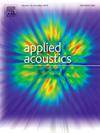Bandgap-controlled acoustic interlayers for low-loss topology transmission
IF 3.4
2区 物理与天体物理
Q1 ACOUSTICS
引用次数: 0
Abstract
Directional induction of acoustic waves has gained increasing attention in recent years. Conventional acoustic topological insulators have drawbacks such as geometrical complexity and difficult processing, which increase the difficulty of engineering applications. In this paper, we propose a scatterer-free and easy-to-machine sonic crystal structure to realize topological acoustic transmission by embedding a cylindrical cavity on a solid substrate. Compared with conventional acoustic metamaterial plates, this structure can significantly enhance the acoustic transmission capability due to the absence of dissipative effect of resonant cavities. The acoustic interlayer structure was designed in parallel, and it was found that band modulation could be realized by changing the distance between the interlayers. This modulation method is different from the traditional method of changing the scatterer structure, which is simpler and more convenient. In addition, the design of the interlayer with no scatterer on the surface allows the placement of various acoustic sensors in the interlayer to realize specific functions. This study provides new design ideas for lightweight devices, high-precision acoustic sensing and low-loss acoustic devices. It also provides a more convenient and effective tuning method to accelerate the engineering of acoustic metamaterials.
用于低损耗拓扑传输的带隙控制声学中间层
声波的定向感应近年来受到越来越多的关注。传统的声学拓扑绝缘体存在几何复杂、加工困难等缺点,增加了工程应用的难度。在本文中,我们提出了一种无散射且易于加工的声音晶体结构,通过在固体衬底上嵌入圆柱形腔来实现拓扑声传输。与传统的声学超材料板相比,由于没有谐振腔的耗散效应,该结构可以显著提高声传输能力。平行设计了声学层间结构,发现通过改变层间距离可以实现波段调制。这种调制方法不同于传统的改变散射体结构的方法,更简单、更方便。此外,中间层表面无散射体的设计允许在中间层中放置各种声学传感器以实现特定功能。本研究为轻量化器件、高精度声学传感和低损耗声学器件提供了新的设计思路。这也为加速声超材料的工程化提供了一种更方便、更有效的调谐方法。
本文章由计算机程序翻译,如有差异,请以英文原文为准。
求助全文
约1分钟内获得全文
求助全文
来源期刊

Applied Acoustics
物理-声学
CiteScore
7.40
自引率
11.80%
发文量
618
审稿时长
7.5 months
期刊介绍:
Since its launch in 1968, Applied Acoustics has been publishing high quality research papers providing state-of-the-art coverage of research findings for engineers and scientists involved in applications of acoustics in the widest sense.
Applied Acoustics looks not only at recent developments in the understanding of acoustics but also at ways of exploiting that understanding. The Journal aims to encourage the exchange of practical experience through publication and in so doing creates a fund of technological information that can be used for solving related problems. The presentation of information in graphical or tabular form is especially encouraged. If a report of a mathematical development is a necessary part of a paper it is important to ensure that it is there only as an integral part of a practical solution to a problem and is supported by data. Applied Acoustics encourages the exchange of practical experience in the following ways: • Complete Papers • Short Technical Notes • Review Articles; and thereby provides a wealth of technological information that can be used to solve related problems.
Manuscripts that address all fields of applications of acoustics ranging from medicine and NDT to the environment and buildings are welcome.
 求助内容:
求助内容: 应助结果提醒方式:
应助结果提醒方式:


